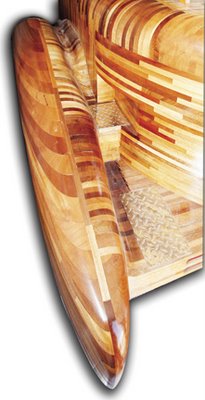



Jerry Nickel spent nearly four years building this masterpiece.
From the website:
There’s little doubt that this car is one of a kind. Nickel got the idea to build a wooden car from an article in a 1955 issue of Hot Rod magazine. Once Nickel retired from the waste collection business, he began making his dream come true. He decided to use two 500-cubic-inch Cadillac V-8 engines because someone told him it wouldn’t work. One engine and transaxle, from an Eldorado, drives the front wheels. The other engine, from a Deville, drives the rear wheels. Although the engines aren’t synchronized, Nickel said they work fine together.
It took Nickel more than four years to form the body by laminating 1-inch strips of mahogany. He used 1,000 board-feet feet of wood cut into 4,183 individual pieces, five gallons of glue, 60 pounds of drywall screws and four gallons of varnish.















0 comments:
Post a Comment